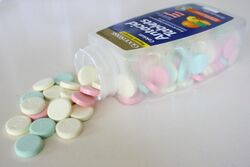Chemistry:Antacid

An antacid is a substance that neutralizes stomach acidity and is used to relieve heartburn, indigestion, or an upset stomach.[1] Some antacids have been used in the treatment of constipation and diarrhea.[2] Marketed antacids contain salts of aluminum, calcium, magnesium, or sodium.[2] Some preparations contain a combination of two salts, such as magnesium carbonate and aluminum hydroxide (e.g., hydrotalcite).[3]
Medical uses
Antacids are available over the counter and are taken by mouth to quickly relieve occasional heartburn, the major symptom of gastroesophageal reflux disease and indigestion. Treatment with antacids alone is symptomatic and only justified for minor symptoms.[4] Alternative uses for antacids include constipation, diarrhea, hyperphosphatemia, and urinary alkalization.[2] Some antacids are also used as an adjunct to pancreatic enzyme replacement therapy in the treatment of pancreatic insufficiency.[5]
Non-particulate antacids (sodium citrate) increase gastric pH with little or no effect on gastric volume, and therefore may see some limited use in pre-operative procedures. Sodium citrate should be given within 1 hour of surgery to be the most effective.[6]
Side effects
Conventional effervescent tablets contain a significant amount of sodium and are associated with increased odds of adverse cardiovascular events according to a 2013 study.[7] Alternative sodium-free formulations containing magnesium salts may cause diarrhea, whereas those containing calcium or aluminum may cause constipation.[8]:{{{1}}} Long-term use of antacids containing aluminum may increase the risk of developing osteoporosis.[9] In vitro studies have found a potential for acid rebound to occur due to antacid overuse, however the significance of this finding has been called into question.[10][11]
Properties of antacids
When an excess amount of acid is produced in the stomach, the natural mucous barrier that protects the lining of the stomach can degrade, leading to pain and irritation.[citation needed] There is also potential for the development of acid reflux, which can cause pain and damage to the esophagus.[citation needed] Antacids contain alkaline ions that chemically neutralize stomach gastric acid, reducing damage to the stomach lining and esophagus, and relieving pain.[1] Some antacids also inhibit pepsin, an enzyme that can damage the esophagus in acid reflux.[2][12]
Antacids do not directly inhibit acid secretion, and thus are distinct from acid-reducing drugs like H2-receptor antagonists or proton pump inhibitors.[4] Antacids do not kill the bacteria Helicobacter pylori, which causes most ulcers.[4]
Interactions
Antacids are known to interact with several oral medications, including fluoroquinolone and tetracycline antibiotics, iron, itraconazole, and prednisone.[13] Metal chelation is responsible for some of these interactions (e.g. fluoroquinolones, tetracyclines), leading to decreased absorption of the chelated drug. Some interactions may be due to the pH increase observed in the stomach following antacid ingestion, leading to increased absorption of weak acids, and decreased absorption of weak bases.[citation needed] Antacids also cause an increase in pH of the urine (alkalization), which may cause increased blood concentrations of weak bases, and increased excretion of weak acids.[14]
A proposed method to mitigate the effects of stomach acidity and chelation on drug absorption is to space out the administration of antacids with interacting medications by at least two hours,[15] however this method has not been well studied for drugs affected by urine alkalization.[13]
There are concerns regarding interactions between delayed-release tablets and antacids, as antacids may increase the stomach pH to a point at which the coating of the delayed-release tablet will dissolve, leading to degradation of the drug if it is pH sensitive.[14]
Formulations
Antacids may be formulated with other active ingredients such as simethicone to control gas, or alginic acid to act as a physical barrier to acid.[16]
Liquids
Several liquid antacid preparations are marketed. Common liquid preparations include milk of magnesia and magnesium/aluminum combinations. A potential advantage of using a liquid preparation over a tablet is that liquids may provide quicker relief, however this may coincide with a shorter duration of action.[17]
Tablets
Chewable tablets
Chewable tablets are one of the most common forms of antacids, most frequently made from carbonate or hydroxide salts, and are readily available over the counter. Upon reaching the stomach, the powdered antacid salts bind to hydronium (H+) ions, producing chloride salts, carbon dioxide, and water. This process reduces the concentration of H+ ions in the stomach, raising the pH and neutralizing the acid.[8]:{{{1}}} Common carbonate salts available in tablet form include those of calcium, magnesium, aluminum, and sodium.[13]
Some common American brands are Tums, Gaviscon chewable tablets, and Maalox chewable tablets.[18]
Effervescent tablets
Effervescent tablets are tablets which are designed to dissolve in water, and then release carbon dioxide.[19][20][21] Common ingredients include citric acid and sodium bicarbonate, which react when in contact with water to produce carbon dioxide. Effervescent antacids may also contain aspirin,[22] sodium carbonate, or tartaric acid.[23] Those containing aspirin may cause further gastric irritation and ulceration due to aspirin's effects on the mucous membrane of the stomach.[24]
Brand names
Some brands include Alka-Seltzer, Gaviscon, Tums and Eno.[25][26]
References
- ↑ 2.0 2.1 2.2 2.3 "Antacids". StatPearls. Treasure Island (FL): StatPearls Publishing. 2020. http://www.ncbi.nlm.nih.gov/books/NBK526049/. Retrieved 24 November 2020.
- ↑ "Aluminum hydroxide and magnesium carbonate Uses, Side Effects & Warnings". https://www.drugs.com/mtm/aluminum-hydroxide-and-magnesium-carbonate.html.
- ↑ 4.0 4.1 4.2 "Consumer Summary – Treatment Options for GERD or Acid Reflux Disease: A Review of the Research for Adults". U.S. Department of Health & Human Services. Agency for Healthcare Research and Quality. 23 September 2011. http://effectivehealthcare.ahrq.gov/index.cfm/search-for-guides-reviews-and-reports/?pageaction=displayproduct&productID=756.
- ↑ "Pancreatic enzyme replacement: the effect of antacids or cimetidine". Digestive Diseases and Sciences 27 (6): 485–490. June 1982. doi:10.1007/BF01296725. PMID 6282548.
- ↑ "Practice Guidelines for Preoperative Fasting and the Use of Pharmacologic Agents to Reduce the Risk of Pulmonary Aspiration: Application to Healthy Patients Undergoing Elective Procedures: An Updated Report by the American Society of Anesthesiologists Task Force on Preoperative Fasting and the Use of Pharmacologic Agents to Reduce the Risk of Pulmonary Aspiration". Anesthesiology 126 (3): 376–393. March 2017. doi:10.1097/ALN.0000000000001452. PMID 28045707.
- ↑ "Association between cardiovascular events and sodium-containing effervescent, dispersible, and soluble drugs: nested case-control study". BMJ 347: f6954. November 2013. doi:10.1136/bmj.f6954. PMID 24284017.
- ↑ 8.0 8.1 "Antacids revisited: review on contemporary facts and relevance for self-management". The Journal of International Medical Research 50 (3): 3000605221086457. March 2022. doi:10.1177/03000605221086457. PMID 35343261.
- ↑ "Taking Antacids". Medline Plus. U.S. Department of Health and Human Services, National Institutes of Health, U.S. National Library of Medicine. 7 November 2014. https://www.nlm.nih.gov/medlineplus/ency/patientinstructions/000198.htm.
- ↑ "A critical look at the clinical use of antacids in acid-peptic disease and gastric acid rebound". The American Journal of Gastroenterology 84 (2): 97–108. February 1989. PMID 2644821.
- ↑ "Calcium and acid rebound: a reappraisal". Journal of Clinical Gastroenterology 15 (1): 37–44. July 1992. doi:10.1097/00004836-199207000-00010. PMID 1500660.
- ↑ "Reflux revisited: advancing the role of pepsin". International Journal of Otolaryngology 2012: 646901. 2012. doi:10.1155/2012/646901. PMID 22242022.
- ↑ 13.0 13.1 13.2 "Clinically significant drug interactions with antacids: an update". Drugs 71 (14): 1839–1864. October 2011. doi:10.2165/11593990-000000000-00000. PMID 21942976.
- ↑ 14.0 14.1 "A Systematic Review of Gastric Acid-Reducing Agent-Mediated Drug-Drug Interactions with Orally Administered Medications". Clinical Pharmacokinetics 59 (4): 447–462. April 2020. doi:10.1007/s40262-019-00844-3. PMID 31788764.
- ↑ Australian Medicines Handbook Pty Ltd (2022). Australian Medicines Handbook 2022. Adelaide, SA. ISBN 978-0-6485158-6-9.
- ↑ "Antacids". IFFGD Publication #520. International Foundation for Functional Gastrointestinal Disorders, Inc. (IFFGD). 12 September 2014. http://www.iffgd.org/site/manage-your-health/diet-treatments/antacids.
- ↑ "In vivo and in vitro evaluation of magnesium-aluminum hydroxide antacid tablets and liquid". Digestive Diseases and Sciences 30 (11): 1049–1052. November 1985. doi:10.1007/BF01315602. PMID 4053915.
- ↑ "Maalox Antacid Oral: Uses, Side Effects, Interactions, Pictures, Warnings & Dosing". https://www.webmd.com/drugs/2/drug-19216/maalox-antacid-oral/details.
- ↑ "Putting the Fizz into Formulation". European Pharmaceutical Contractor (Autumn). 2013. http://www.samedanltd.com/magazine/11/issue/204/article/3622.
- ↑ "Tablets". British Pharmacopeia. 2003. http://www.newdruginfo.com/pharmacopeia/bp2003/British%20Pharmacopoeia%20Volume%20III/Monographs/Formulated%20Preparations%20Genearal%20Monographs/TABLETS.htm.
- ↑ International Pharmacopoeia 2006. World Health Organization. 2006. pp. 966. ISBN 978-92-4-156301-7. https://archive.org/details/bub_gb_s_sBKJNf184C. Retrieved 1 July 2013.
- ↑ "Alka Seltzer Directions of use, Sodium & Aspirin content – Alka Seltzer relief from Headaches, Migraine & Upset stomach". alkaseltzer.ie. http://www.alkaseltzer.ie/en/about-alka-seltzer/.
- ↑ "Kirk-Othmer Encyclopedia of Chemical Technology". Kirk Othmer Encyclopedia of Chemical Technology. 2000. pp. 1–19. doi:10.1002/0471238961.0825041802120109.a01. ISBN 978-0471238966.
- ↑ "Aspirin and the stomach". Annals of Internal Medicine 104 (3): 390–398. March 1986. doi:10.7326/0003-4819-104-3-390. PMID 3511824.
- ↑ "Which OTC Meds Treat Heartburn?". 30 March 2023. https://www.webmd.com/heartburn-gerd/treating-heartburn-over-counter-medicine.
- ↑ "Eno – Summary of Product Characteristics at eMC". https://www.medicines.org.uk/emc/medicine/21528. "Last updated 1 January 2016"
External links
 |


